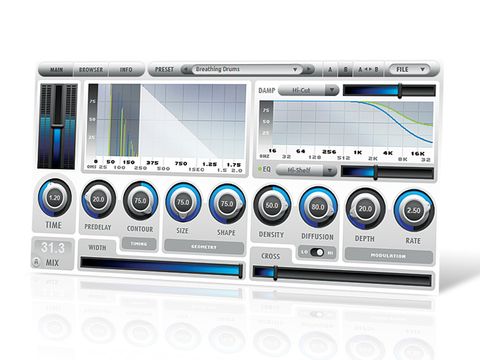Here we have another algorithmic reverb plug-in, available in 32 and 64-bit versions for PC and Mac, in VST, AU and RTAS formats.
This is 2CAudio's second reverb, the first being the considerably more complex Aether. While Breeze has much in common with its forebear, it's not a straight cut-down version of it.
The interface is concisely laid out, with a familiar graph display that represents the reverb generated by the current settings. We'll tackle the controls from left to right, as they're logically laid out.
First up, the Time control can be dialled from 100ms all the way to infinity - ie, a 'hold' setting, which is great for huge-sounding FX. The predelay control goes up to a slapback-tastic 250ms.
Worthy of special mention is the Contour control, which essentially adjusts the amplitude envelope of the early stages of the reverb. It's a similar concept to the Attack/Sustain/Spread controls we love so much in Aether.
It enables many different reverb styles to be dialled in, and is also highly useful for shifting the 'timing' of the reverb to suit your song/mix. Just as useful are the Width and Cross sliders that allow you to adjust the stereo image of the reverb - they're great for reining in overly large sounding presets or expanding small ones.
These controls are more advanced than your typical stereo width adjustment, and even affect how the reverb algorithm works. The excellent manual goes into great detail on this.
Size and Shape govern those characteristics of the virtual room, while Density and Diffusion can be thought of as controlling the richness and smoothness of the reverb tail. Over on the far right are Depth and Rate controls for dialling in lush tail modulation.
The section just above lets you choose from five filter types for both EQ and damping.
Blown away
2CAudio's previous reverb plug-in - Aether 1.5 - sounds fantastic, but it's quite CPU-heavy (especially with the quality settings cranked up) and takes time to fully master.
It's a pleasure to report that Breeze is, by design, less CPU-intensive and much easier to grasp. Its graphical stylings are reminiscent of Aether's, but it's nowhere near as daunting, with far fewer controls. This means less flexibility, but there's more than enough control for typical reverb duties.
It would be wrong to dub Breeze a cutdown version of Aether, though. In fact, Breeze has a few aces up its sleeve when compared to its older sibling, such as its stereo options, the graphical reverb display, a low-CPU Density/Diffusion mode switch, and an "evolved" modulation method that's said to be more akin to real spaces.
If you're interested, 2CAudio's website details Breeze's special features.
Shooting the breeze
Putting Breeze to work in a mix is, well, a breeze! The relatively conservative control count means it's quick to get to grips with and doesn't leave you scratching your head as to how best to proceed, as could be the case with Aether.
The Lock button on the Mix control lets you lock the mix level while flicking through presets, with further conveniences including A/B comparison and four interface skins.
There's a vast array of presets included, sensibly named and arranged in banks such as Halls, Chambers, Instruments, Vocals, Ambience, etc, which is very handy when you're after something specific.
Most usefully, Breeze adjusts its output level automatically, producing a similar volume regardless of what adjustments you make or presets you choose. This makes auditioning/comparing settings and finding suitable presets a lot easier than we're used to.
Sonically, Breeze is every bit as good as we expected from 2CAudio, standing tall among the best modern algorithmic reverbs we've tried. It's primarily a bright and airy affair, but darker sounds can be configured as well.
We'd be more than happy to employ it in any mix situation, and it's a dab-hand at FX-orientated sounds, too. Breeze is for those who like their plug-ins to-the-point and easy-to-use, as there's really nothing superfluous to be found here.
It's a joy to employ and comes very highly recommended indeed. Superb.
Now listen to our audio demos to hear Breeze in action:
Drumloop - Percussion Room
Drums - Snare Room
Pad - Giant Sucking Sound
Piano - Piano Ambience
Vocal - Large Hall


